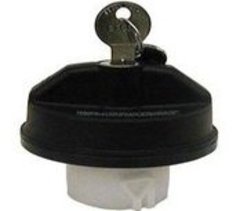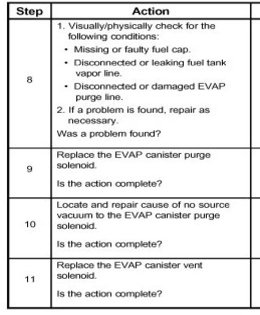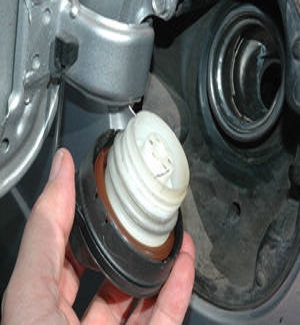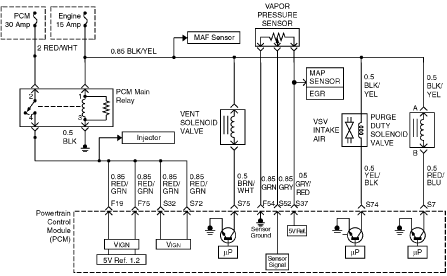
The gas cap code is a common diagnostic trouble code that might turn your check engine light on. I put together a video discussing a problem my neighbor had with Nissan Maxima four door sedan after they filled the fuel tank.
It’s a common scenario I see all too often. As you can see in the ladder diagram from the Nissan service manual, action step 1A is to check the fuel cap. By popular demand I added a common evap system electrical diagram at the bottom.
Watch the short video and review the diagrams to see how this system works. First, let’s talk a little more about the gas cap code and the possible causes. Many mechanics and drivers consider this a nuisance code. It doesn’t change how the engine runs. The truth is the government mandates this code to protect the atmosphere from fuel vapors.

The check engine light will come on and set a code if the fuel system isn’t sealed airtight. There’s also a possibility you have a bad fuel tank pressure sensor.
On some automobiles these issues set the P0440 code. I also want to talk more about the evaporation emissions system.
This sensitive arrangement of parts sets other diagnostic trouble codes in the P0400 range. After posting my short video on YouTube I received many comments saying the gas cap isn’t the only reason that a p0440 code will set.
I agree, and was just saying the most common cause is a loose or broken gas cap. Not the only cause. When dealing with these issues lets remember the basic function of the evap emissions control system.
The emission control system intends to eliminate or at least reduce the amount of fuel vapor released into the atmosphere. This became part of the clean air act amended by our Federal Government.
More about Emissions Codes
 These laws required car manufacturers to install malfunction monitoring systems. Now car makers automatically check the integrity of the fuel system and its ability to completely seal.They also had to notify the driver of any problems by turning on the malfunction indicator lamp (MIL) if the system has a failure.
These laws required car manufacturers to install malfunction monitoring systems. Now car makers automatically check the integrity of the fuel system and its ability to completely seal.They also had to notify the driver of any problems by turning on the malfunction indicator lamp (MIL) if the system has a failure.
The parameters that turn on the check engine light will differ between make and models. However, many use a pressure test to confirm that no leaks are present from the tank and lines.The most common way manufacturers perform the test is with a small pressure pump connected to the system.
When the control module runs an automatic diagnostic, it turns on the pump, pressurizing the system. As air pressure builds the cycling rate of the pump decreases.If there is no vapor leaks the pressure builds until the pump shuts off and the test has passed. If there is a leak the pump runs too long and the test fails. The P0440 – P0459 series of diagnostic trouble codes are set depending on the results of this automatic test.
Gas Caps and Check Engine Lights

If the rubber seal on the fuel cap isn’t sealing, because the cap is loose or cross threaded, the test fails. The pump never reaches its desired pressure and therefore triggers the service engine soon light.
It’s also possible the fuel cap is screwed on properly, but still leaks from either the o-ring gasket seal or the body of the cap itself. Often gas caps are made of several parts even if they look one piece.
Thankfully, they make inexpensive scan tools that just read and clear codes.
However, there are no guarantees it’ll solve all your problems. Yes, sometimes it’s much more complicated than just replacing or tightening the gas cap. I have seen crazy things like spider nests in vent lines and leaking fuel pressure sensors cause a p0454 code.
The Hard to Fix Gas Cap Code

Maybe the worst situation is when small leaks are detected by the electronic control module. These can be real hard to find.
Dealers and the shop I work at have a smoke machine that hooks to the system and pumps smoke into the lines, valves, canister and solenoids.
When we see this machine roll out of the tool room we know someone is struggling with a tough diagnosis. The idea is, you should be able to see a smoke monster leaking from any problem area.
In my opinion the best way to solve any check engine light is to first retrieve the specific diagnostic trouble code. Then follow the ladder repair diagram until the problem is solved.
Below is the video that shows you the tree chart for the P0440 gas cap code. If you put it in full screen mode you can actually see the individual steps.
A Bargain Scanner with Advanced Features

I use to recommend the Actron 9410 scan tool I used in the video. The CP9410 pocket scanner reads and erases codes, but it also tells you how urgent they are. This urgency indicator is easy to understand, because it uses green, yellow and red to indicate the severity of set codes. Unfortunately, it seems like it’s no longer available new.
So here is the Equus 3100 scan tool which at the time of this writing is the scan tool I recommend. It’s an older model, but provides a good balance between price and features. For around 100 bucks this thing has on screen definitions and freeze frame or snapshot capabilities. Remember, some codes are important to fix quickly.
A good example of a code that could harm your vehicle would be an engine misfire code. If you have a cylinder not firing, raw fuel could be dripping into your catalytic converter. This could damage the catalytic converter itself. This is an expensive car part, that bad people have been stealing in good peoples driveway’s.
Also raw fuel lying in the exhaust could possibly be dangerous if not addressed. Then you have the flip side of the equation with the p0440 gas cap code. This code is not good for the environment, but it will not affect the safety or reliability of your automobile. For more information about what else can turn on the service engine soon light visit my page dedicated to the dreaded check engine light.
For more information about the car mechanic that built this website visit the homepage. Here you can get a brief rundown of available information on the subject of Diy auto repair.
If you like short educational auto repair videos I have a few you might find interesting. This next link takes you to more auto repair videos.


